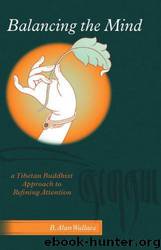Balancing the Mind: A Tibetan Buddhist Approach to Refining Attention by B. Alan Wallace

Author:B. Alan Wallace
Language: eng
Format: azw3
Publisher: Snow Lion
Published: 2005-06-25T00:00:00+00:00
Moreover, in the cultivation of mere non-conceptual attention, without focusing on any other basis of meditation such as the form of a deity, resolve, "I shall settle the mind without thinking about any object." Then without letting the attention become scattered, avoid distraction. Non-distraction, too, is identical with mindfulness that does not forget the meditative object, so it consists of nothing more than the cultivation of mindfulness. Therefore, in such meditation, too, mindfulness is cultivated in which the potency of ascertaining consciousness emerges.
COMMENTARY: As Tsongkhapa now begins explaining specific methods for cultivating quiescence, he emphasizes the indispensable role of sustained attention. The approach that he endorses to accomplish such samadhi centers on the vigorous implementation of mindfulness and introspection. The emphasis here is on maintaining strict control over the attention by sustaining it rigorously with mindfulness and monitoring the attention with introspection. In short, in the early stages of this training lapses in the continuity of attention are curbed with the swift intervention of introspection, in accordance with the analogy of punitively jabbing a wild elephant with a sharp hook.
To bring forth powerful mindfulness and the potency of clarity, Tsongkhapa insists that the mind must firmly apprehend, or ascertain, its meditative object. Otherwise, there is the danger that as the attention is stabilized, the mind will become peacefully nebulous and stupefied due to the onset of laxity. However, in his closing comments in the above section, Tsongkhapa does allow for the possibility of developing quiescence through "the cultivation of mere non-conceptual attention, without focusing on any other basis of meditation." This technique, prominent in the meditative traditions of Mahamudra59 and Atiyoga,60 is described concisely by Panchen Lozang Chokyi Gyaltsen6' (1570-1662):
Download
This site does not store any files on its server. We only index and link to content provided by other sites. Please contact the content providers to delete copyright contents if any and email us, we'll remove relevant links or contents immediately.
| Acupuncture & Acupressure | Aromatherapy |
| Ayurveda | Chelation |
| Chinese Medicine | Energy Healing |
| Healing | Herbal Remedies |
| Holistic | Homeopathy |
| Hypnotherapy | Massage |
| Meditation | Naturopathy |
| Reference |
Inner Engineering: A Yogi's Guide to Joy by Sadhguru(6728)
The Power of Now: A Guide to Spiritual Enlightenment by Eckhart Tolle(5610)
Fear by Osho(4663)
Ikigai by Héctor García & Francesc Miralles(4125)
The Art of Happiness by The Dalai Lama(4065)
The Ultimate Bodybuilding Cookbook by Kendall Lou Schmidt(3886)
Yoga Therapy by Mark Stephens(3705)
The Little Book of Hygge by Meik Wiking(3648)
The Healing Self by Deepak Chopra(3478)
Why Buddhism is True by Robert Wright(3405)
The Hatha Yoga Pradipika (Translated) by Svatmarama(3237)
Being Aware of Being Aware by Rupert Spira(3231)
Shift into Freedom by Loch Kelly(3139)
Wild Words from Wild Women by Stephens Autumn(3095)
Work Clean by Dan Charnas(3055)
Happiness by Matthieu Ricard(2996)
More Language of Letting Go: 366 New Daily Meditations by Melody Beattie(2972)
Yoga Body & Mind Handbook by Jasmine Tarkeshi(2836)
Why I Am Not a Feminist by Jessa Crispin(2697)
